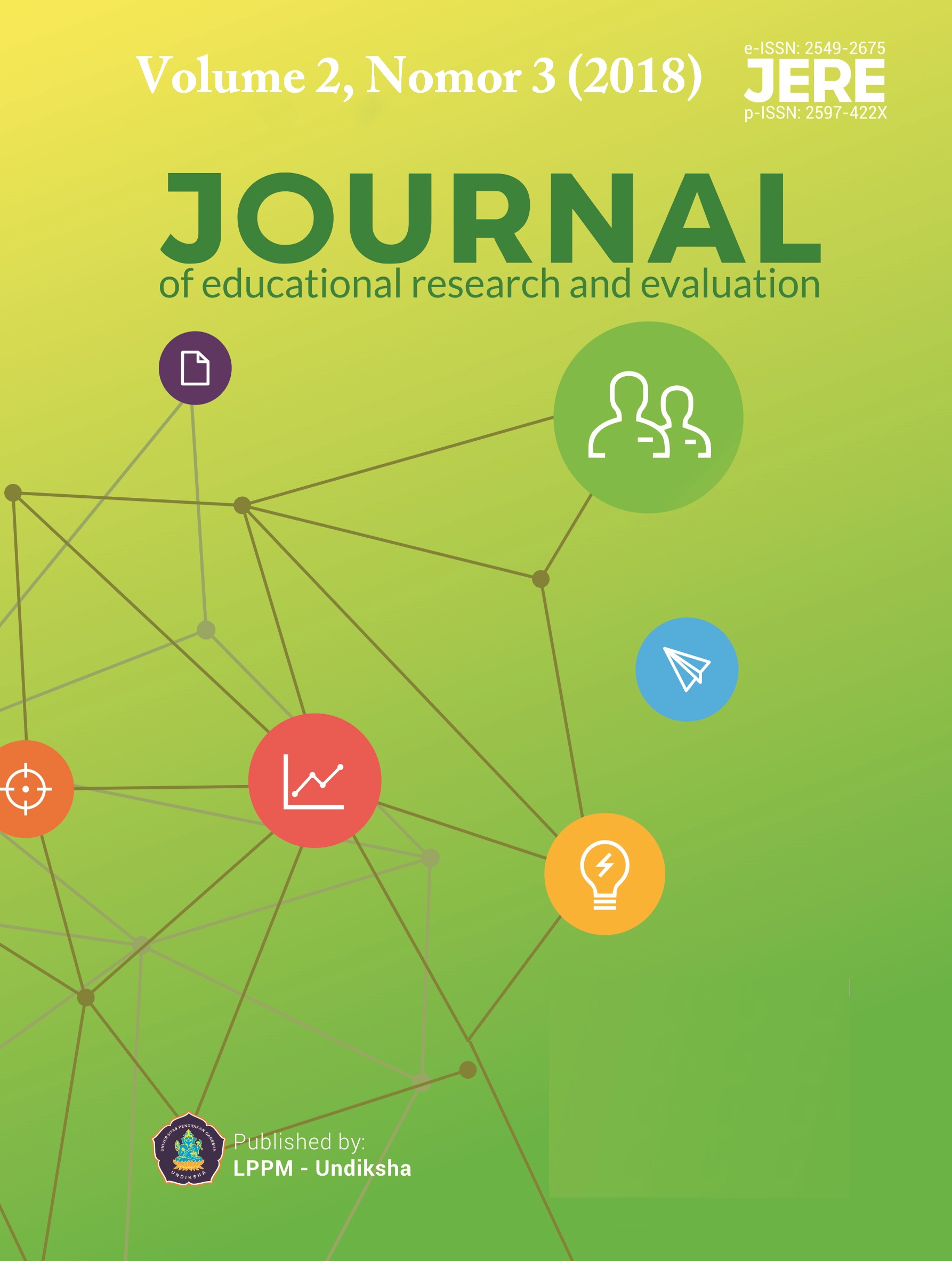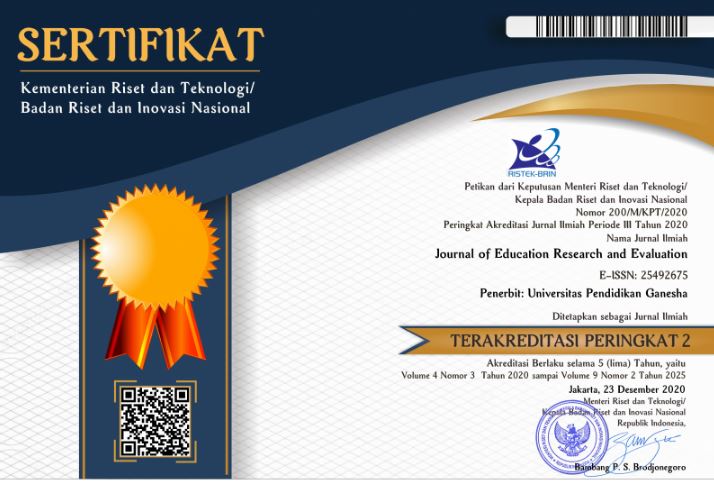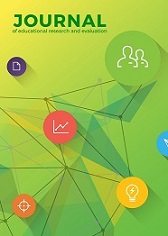Developing Learning Media of Adaptive Sport Course in SLLB Negeri 2 Padang
DOI:
https://doi.org/10.23887/jere.v2i3.15676Keywords:
Media PembelajaranAbstract
In this study the problem was that the implementation of Penjasorkes learning was not maximum in SLB N 2 Padang. The implementation of Penjasorkes learning had not been success caused by a teaching strategy that was not appropriate with the condition such as the use of learning media that had not been able to provide physical education effectively and efficiently to students. So that it made the students were less creative and less motivated in doing physical activities, especially athletic material and the basic movements of running, throwing and jumping which were presented in the form of game. This research included development research that aimed to produce athletic learning media through playing with basic movements of running, jumping, and throwing for mentally retarded students at SLB N 2 Padang. Finally, this research was expected to contribute and be useful for the development of science especially in the field of physical education, sports and health. It could be concluded that there was a significant effect of the development of learning media on the basic athletic abilities of students in SLB N 2 Padang with an increase 3.49 in the average score, from the average score of pre test 50 and the post test 53.49.References
Ainin,Ima Kurrotun. 2011. Strategi Pembelajaran Pendidikan Jasmani Adaptif (Penelitian pada Guru Pendidikan Jasmani Adaptif Sekolah Dasar InklusifKota Surabaya). AfJl.Anakku, Volume 10, Nomor 2.
Astuti, Yuni. 2017. Pengembangan Permainan Kolaboratif Dalam Pendidikan Jasmani Dan Olahraga Di Sekolah Dasar Untuk Optimalisasi Pembentukan Karakter. Jurnal Pendidikan Jasmani dan Olahraga Volume 9 Nomor 2. September 2017.
Erianti, 2011. Pendidikan Jasmani Adaptif. Malang, Wineka Media.
Gay, LK. 1981. Educational Research: Competencies for Analysis & Application Columbus. Charles E. Merril Publishing.
Giri Wiarto. 2016. Media Pembelajaran Dalam Pendidikan Jasmani. Yokyakarta, Glaksitas.
Hadis. 2006. Pendidikan Anak Berkebutuhan Khusus Autistik. Bandung: Alfabeta. IKAPI.
Haryoko. 2012. Pengembangan Model Pembelajaran Keterampilan Dasar Sepakbola Peserta Ekstrakurikuler Sepakbola SMP Negeri di Kota Malang, Jakarta: PPS UNJ.
Hosni. 2003. Pembelajaran Adaptif untuk Sekolah Luar Biasa. Jakarta: Depdiknas.
Imam dan Agus. 2015. Pengembangan Model Pembelajaran Gerak Dasar Lari melalui Permainan ”Throw and Run” Pada Siswa Berkebutuhan Khusus (Tunarungu) di SDLB Negeri Semarang Tahun 2015. Semarang: Journal of Physical Education, Sport, Health and Recreations. 4(7)(2015)
Lufthansa. 2017. Pengembangan Model Pembelajaran Atletik Nomor Lempar untuk Anak Tunagrahita Ringan. Malang:Jurnal Keolahragaan, 5 (1), 2017, 39-49.
Mariam. (2001). Pendidikan Kebutuhan Khusus Sebuah Pengantar (terjemahan). Bandung: Program Pascasarjana UPI
Muhammad Fauzi. 2012. Model Pembelajaran Menggiring Bola Dengan Pola Pendekatan Bermain untuk Pendidikan Jasmani. Jakarta: Pascasarjana UNJ.
Mujianto, Gracia Elora. 2015. Pengembangan Model Pembelajaran Penjas Adaptif Melalui Media Permainan Rainbow Flag Pada Siswa Tunarungu SMPLB Negeri Semarang. Journal of Physical Education, Vol 2, No 1.
Rahim, Abdul. 2018. Pengembangan Model Pembelajaran Pendidikan Jasmani Adaptif Bagi Anak Berkebutuhan Khusus Di Sekolah Dasar Inklusif Kota Yogyakarta. Trihayu: Jurnal Pendidikan Ke-SD-an, Vol. 4, Nomor 2.
Sudjana. 1990. Penilaian Hasil Proses Belajar Mengajar. Bandung: Rosdakarya.
Sugiyono. 2010. Metode Penelitian Pendidikan. Bandung: Alfabeta.
Sumaryanti. 2011. Diseminasi Model Pembelajaran Jasmani Adaptif Untuk Optimalisasi Otak Anak Tunagrahita:Tinjauan Terapi Fisik Dan Neurosains. Yogyakarta: JURNAL KEPENDIDIKAN. Volume 40, Nomor 1, Mei 2010, hal. 2944
Undang-undang Sistem Pendidikan Nasional No. 20 Tahun 2003
Widya, M. D. A. 2004. Belajar berlatih gerak-gerak dasar atletik dalam bermain. Jakarta : Raja Grafindo Persada.
Willadi, Rasyid. 2011. Strategi Model Pembelajaran Penjaskesrek. Padang: Sukabina Press.
Downloads
Published
How to Cite
Issue
Section
License
Authors who publish with the Journal of Evaluation and Research in Education (JERE) agree to the following terms:
- Authors retain copyright and grant the journal the right of first publication with the work simultaneously licensed under a Creative Commons Attribution License (CC BY-SA 4.0) that allows others to share the work with an acknowledgment of the work's authorship and initial publication in this journal.
- Authors are able to enter into separate, additional contractual arrangements for the non-exclusive distribution of the journal's published version of the work (e.g., post it to an institutional repository or publish it in a book), with an acknowledgment of its initial publication in this journal.
- Authors are permitted and encouraged to post their work online (e.g., in institutional repositories or on their website) prior to and during the submission process, as it can lead to productive exchanges, as well as earlier and greater citation of published work. (See The Effect of Open Access)











